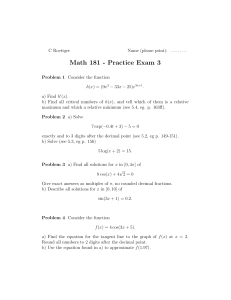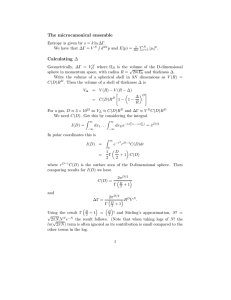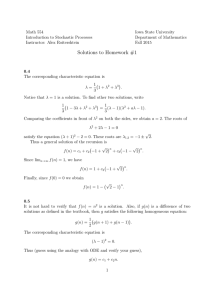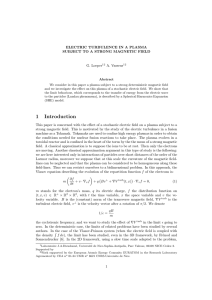Math 181 - Practice Exam 3 - solutions
advertisement
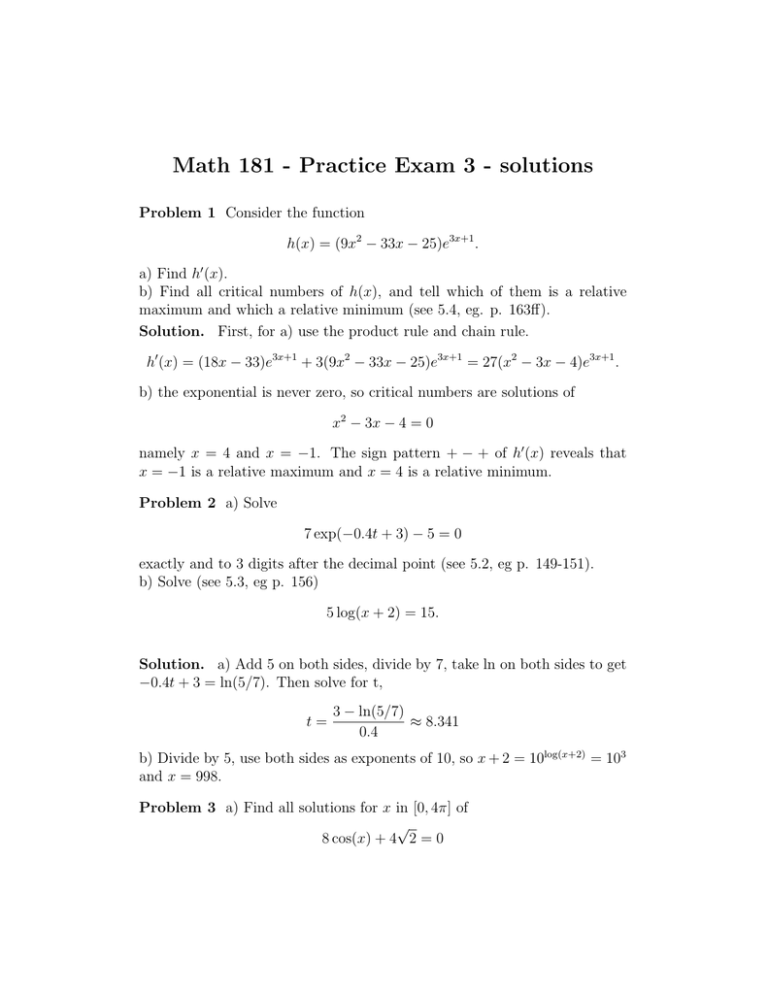
Math 181 - Practice Exam 3 - solutions Problem 1 Consider the function h(x) = (9x2 − 33x − 25)e3x+1 . a) Find h0 (x). b) Find all critical numbers of h(x), and tell which of them is a relative maximum and which a relative minimum (see 5.4, eg. p. 163ff). Solution. First, for a) use the product rule and chain rule. h0 (x) = (18x − 33)e3x+1 + 3(9x2 − 33x − 25)e3x+1 = 27(x2 − 3x − 4)e3x+1 . b) the exponential is never zero, so critical numbers are solutions of x2 − 3x − 4 = 0 namely x = 4 and x = −1. The sign pattern + − + of h0 (x) reveals that x = −1 is a relative maximum and x = 4 is a relative minimum. Problem 2 a) Solve 7 exp(−0.4t + 3) − 5 = 0 exactly and to 3 digits after the decimal point (see 5.2, eg p. 149-151). b) Solve (see 5.3, eg p. 156) 5 log(x + 2) = 15. Solution. a) Add 5 on both sides, divide by 7, take ln on both sides to get −0.4t + 3 = ln(5/7). Then solve for t, t= 3 − ln(5/7) ≈ 8.341 0.4 b) Divide by 5, use both sides as exponents of 10, so x + 2 = 10log(x+2) = 103 and x = 998. Problem 3 a) Find all solutions for x in [0, 4π] of √ 8 cos(x) + 4 2 = 0 Give exact answers as multiples of π, no rounded decimal fractions. b) Describe all solutions for x in [0, 10] of sin(3x + 1) = 0.2. Solution. a) Divide by 8, solve for cos x, so √ 2 . cos x = − 2 √ Then x1 = arccos(− 2/2) = 3π/4 is a solution. Another solution is 5π . 4 All solutions are then x1 + 2πn, x2 + 2πn for all integers n. b) We put t = 3x + 1 and first find possible values of t: x2 = 2π − x1 = t1 = arcsin(0.2) ≈ 0.20 is the one solution in [−π/2, π/2], and t2 = π − t1 ≈ 2.94 is another one which we get from the symmetry of the sine graph (you could make a quick sketch of a unit circle with the corresponding points on it, the sine function is the y-coordinate of these points). All possibilities for t are then t1 + 2πn, t2 + 2πn for integers n. Going back to x= t−1 3 we get the corresponding solutions x1 ≈ −0.27 x2 ≈ 0.65. Finally, since this function is periodic with period 2π/3, all solutions are of the form x = x1 + 2πn/3 or x = x2 + 2πn/3. Making a list of these values, we select the ones in [0, 10] as n 0 1 2 3 4 x1 + 2πn/3 N/A 1.83 3.92 6.02 8.11 x2 + 2πn/3 0.65 2.74 4.84 6.93 9.02 In the plot below, solutions are the x-values where the red line crosses the sine graph. Problem 4 Consider the function f (x) = 4 cos(3x + 5). a) Find the equation for the tangent line to the graph of f (x) at x = 2. Round all numbers to 2 digits after the decimal point. b) Use the equation found in a) to approximate f (1.97). Solution. a) First, the derivative of f (x) is f 0 (x) = −12 sin(3x + 5). (use the chain rule!). For x = 2, we get f 0 (2) = −12 sin 11 ≈ 12.00 and f (2) ≈ 0.02. So the desired tangent line has equation y = 12(x − 2) + 0.02. b) Plug in x = 1.97 to get y = 12(1.97 − 2) + 0.02 = −0.34. Note that the true value is −0.3418795..., we have a very accurate approximation. Problem 5 This table gives the body temperature of some child with a slight ’temperature’, measured every two hours and using a 24-hour clock. Suppose the temperature repeats its values every 24 hours, and that it can be exactly described by (see 5.6 for f) and g), but a)-e) not in notes) f (t) = A cos(ω(t − B)) + C. a) What is the most sensible value for ω? b) What is the minimum and maximum temperature in the table? c) What is the most sensible value for A? d) What is the most sensible value for C? e) What is the most sensible value for B? f) What will the temperature be at 3pm, according to your function? g) At what time(s) is the temperature 97.6 degrees? 2 4 6 8 10 12 14 16 18 20 22 24 Hour Body Temp 96.3 96 96.3 97 98 99 99.7 100 99.7 99 98 97 Solution. a) ω = 2π/24 because we want to repeat every 24 hours. b) 96, 100 degrees. c) A = 2 (half the spread 100 − 96 = 4). d) C = 98 (average of min and max, guarantees minimum, maximum are correct). e) B = 16 since that is the first time when the maximum occurs. So our function is f (t) = 2 cos(2π(t − 16)/24) + 98. f) substitute t = 15 (24-hour clock!) and get f (15) = 2 cos(2π(15 − 16)/24) + 98 ≈ 99.9319 g) f (t) = 97.6 can be solved for cos(π(t − 16) ∗ /12) = −0.4/2 = −0.2. The calculator gives you π(t − 16) = cos−1 (−0.2) ≈ 1.77 12 It will always give angles in [0, π]. The other solution in [0, 2π] is x1 = x2 = 2π − x1 = 4.51. Given these values for x, we then solve this for t, t= 12 · 1.77 + 16 ≈ 22.77 π and for the value x2 we’ll get t = 12 · 4.51 + 16 ≈ 33.23 π Then we can add or subtract any multiple of 24 hours to get other solutions for t. In particular, t = 9.23 is the only other solution within the 24-hour window we are looking at. Problem 6 One measure M of hearing damage due to noise involves the logarithm of the frequency of noise. Let ω be the noise frequency, V a measure of its volume, and ω M = V ln +1 1000 the measure of noise (this means that noise of a given volume gets higher M -value with increasing frequency). Suppose that V = 100 is constant, and that ω changes over time t with ω 0 (t) = 5 at a time when ω = 440. Find the rate of change of M at that moment in time. (See 4.7, eg examples on p. 140 and combine with 5.4) Solution. Use the Chain Rule, Dt M = Dω M · Dt ω. This gives Dt M = V ω 0 (t) 5V · = ≈ 0.347. ω(t)/1000 + 1 1000 ω + 1000 Problem 7 A population of snails is counted every week. Assume that the number S of snails obeys the law F (S) = 1.036S + 0.012S log(S) (1) a) If initially, there are 100 snails, how many snails are there after 2 weeks? b) What is the positive equilibrium for the number of snails? c) What is the maximum sustainable harvest? (See examples in 4.5, eg p. 126/7 and 5.5, problem 6-7). d) What is the breeding population for the maximum sustainable harvest? Solution. a) After 1 week: 106. After 2 weeks: 112.39. b) Solve the equation F (S) = S, 0 = 0.036S + 0.012S log(S) = S(0.036 + 0.012 log(S)) where we are supposed to discard S = 0. Then S = 0.001 from 0.036 + 0.012 log(S) = 0 which leads to log(S) = −3 so S = 0.001. c), d) We want to maximize H = F (S) − S as in section 4.5. H 0 = 0.036 + 0.012(log(S) + 1/ ln(10)). Solving H 0 = 0 gives the critical value S = 10−3−1/ ln(10) . The sign pattern of H 0 is −+, so for this value of S, H is actually a minimum! This means there is no maximum sustainable harvest, for bigger and bigger values of S we get bigger and bigger values of H!
